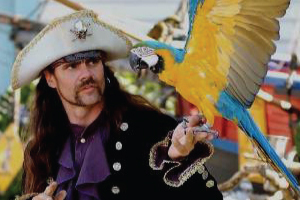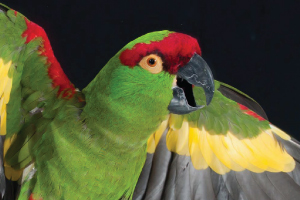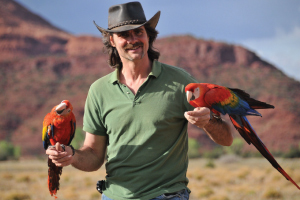
Building Interest In Food Rewards
Creating A Food Motivated Bird
Written By Chris Biro, Copyright 2008
The problem of not having a food motivated bird is likely a problem of improper food management – I don’t mean to offend with this just point out that this condition exists for a reason. Animal trainers SHOULD be managing all of the things the animal desires that we have the ability to limit access to, otherwise the animals are just being housed between training sessions and not really in an over all training program. This includes aspects of social contact, opportunities to play with certain items or with certain friends, food, etc. But food as a tool will be most useful if it is being managed. There are several different approaches to managing food for training purposes that can help you have a bird that is willing to work for food treats.
There are a couple approaches that have names many of us are familiar with, though these are not official OC names. Favorite Treat “method” and Weight Management method are probably the two most commonly used. A third approach is used by some on the list but I have not seen a name associated with it. I will here call it Controlled Free Feed method. In addition there are strategies that can be used to make certain items of food more desirable independent of hunger.
Weight management is where the animal is given only enough food to be kept at a specific weight. This is one way of making sure the animal remains hungry enough to work for food. Hunger cannot be measured directly but weight can. It can be assumed that if an animal is some amount below its normal weight that the animal is hungry. How hungry is determined by paying close attention to how well the animal responds to training. If the animal is working well at a given weight then that weight means the animal is hungry enough to be interested in the offered food items. Adjusting the weight until the animal’s performance is at a desired response level is the key to weight management programs.
There are some potential dangers to new people using weight management. A similar thing can happen with weight management as happens with the use of punishment. The trainer is reinforced for successful application of aversives when punishment seemed to work and thus has a tendency to continue or increase use of punishment methods in the future. So too can weight management have a similar problem. If lowering the animal’s weight produced results then the trainer is reinforced and thus more likely to lower weight again. If not approached with a serious focus on the animals response levels, this can easily turn into a mind set of “lower the weight if there is a problem”. That is not always the right thing to do and like with punishment can result in inhumane treatment of the animal or worse be dangerous to the animals health.
There is also the problem of the new trainer not understanding what is causing the animal to fail to perform. There are many reasons an animal might not perform a task, hunger is only one of them. If the trainer misidentifies the reason as being not hungry enough then the trainer will likely lower the weight again. The real problem might have been a distracting/disturbing item in the area or an illness or various other factors that can reduce responses independent of hunger. Reducing the animals weight for the wrong reasons can be dangerous to the animals health and general well being. An animal whose weight is lowered too low will exhibit serious signs of stress and other undesirable symptoms.
Favorite Treat Method (an unofficial name) is focused more on the selection of the treat item rather than the animals hunger level or weight. The main idea is to find items of food that the animal desires for reasons other than just being hungry. Food is desirable for many reasons: the animal enjoys the flavor or taste, enjoys the texture or feel, enjoys the act of opening the item to get to it (sunflower seeds seem to be more enjoyed when in the hull), or the animal is feeling hungry and eating the item will help reduce those feelings of hunger. Selecting an item of food for training that the animal desires and will WORK for is the key to this method. Like with weight management, the animal’s response level is the key element that defines how effective the item is. Where weight management is mostly gauging level of hunger, favorite treat is mostly gauging how desirable the item is. Obviously the two methods have some common elements and can be used concurrently.
The Controlled Free Feed method (unofficial name) I have seen is limiting access to food until a specific time of day, at which time the animal can eat all it wants. No weight is measured since the animal does free feed when given access to the food and thus weight loss is not part of this approach. This approach is also mostly focused on the use of hunger to motivate the animal but does also include an element of routine. Animals will often do things in a routine so once a routine is established it can be easier to get them to do certain behaviors, like go back onto a cage at the same time everyday. Feeding routines can also be adjusted to get the best performance for optimal times of day – late evenings will be easier to get birds to go to roost thus easier to feed and get them back into a cage at this time of day.
Strategies for Increasing Interest in food items can include: limiting access to that particular food item; limiting the kinds of food they get when not eating this food item (feeding less exciting food for a period of time or full time will increase value of favorite item – feeding pellets will make seeds as treats more valuable); letting them occasionally get truly hungry can help them understand that food is valuable when it is present; and periods (days to weeks) when the animal does not have free access to foods all the time will make feeding opportunities more valuable – they may like an item but not be interested in it during training because they think it or another will be there whenever they feel like getting around to it. Some of these will need to be implemented more frequently to keep food items valued during training sessions and others will only need to be learned once. But the key focus here is to make the items of food valued independent of hunger.
Myself I use mostly the favorite treat method and sometimes boost its effectiveness by controlling their access to food prior to training, thus adding some appetite/hunger interest in the food beyond the desire for the item of taste etc. I also use most of the strategies for increasing interest in food items. When on the road doing shows we do use the controlled free feeding method – the birds are fed all they want when returning to the motor home at the end of our 6 hour day. I almost never find myself needing to resort to withholding food to reduce weight.
Other inherent interests the birds have can also be used for training. Interests such as social needs, play needs, security needs, pair bonding needs, etc. Each of these though will take “building” up to a level and manner usable for training. Anything the animal desires that you can control access to and that you can dispense in a timely and controlled manner is potentially a good reinforcer for training purposes. The more of these alternatives we have available and know how to use, the more effective we will be at getting the behavior we desire from our animals.
Parrots: more than pets, friends for life.Chris Biro
Resources and More
The Pirate's Parrot Show
An educationally based pirate-themed parrot show performing at state and county fairs since 1991. The Pirate’s Parrot Show is a Fun, Educational, and Interactive experience for all ages and cultures.
Bird Recovery International
One in every eight bird species in the world today is in danger of extinction and these numbers are increasing! Find out how this non-profit organization started by Chris Biro can help save and protect parrots and other birds.
Podcasts with Chris Biro
An Alternate Perspective – Enjoy these audio Podcasts of Chris with guests discussing the nature of training flighted birds. The discussions are intended to be loosely structured around a general topic.
Email Us
chris@libertywings.com
Call Us
(206) 618-2610
Contact Us
By Using the Contact Form




I read this article too, so I will try this. I am not sure if it is possible to train a rescue bird, but I feel I have a good candidate for it. Thanks so much for sharing your experience.
Yes it is possible to train a rescue bird. Every animal can be trained. Training is simply organized learning via a teacher or coach. The rescue bird may have some history issues to overcome or it may not. Flight training an older bird is doable but not as simple or quick as training a fledgling aged bird. Chris
so i have a red front macaw whats the best age to train to fly i should be able to train him at one year old is that the harder age to train??? hes 4 months old now and i am not planning on clipping his wings when they molt again as they are currently clipped
Hi, I’ve been using a training diet similar to this with our female Eclectus parrot. It is really a big difference in our training sessions and she is making lot of progress..What I’ve noticed is she is getting louder, I know this only makes sense but is there anything I can do to stop the behavior? We aren’t giving her any attention for it, not even eye contact, but is there a more effective way of getting rid of this behavior?
What do you mean by “training diet”? If you mean you are holding back food to lower the birds weight, I do not encourage you do that for training a parrot to fly outdoors. I let our bird eat as much as they want at the end of the day. Their weight never drops this way. But in the morning when they are hungry, I can train them using a favorite food item, such as a shelled peanut or sunflower seed and they are motivated to get the goody.
Hi. I’m curious about what your birds eat when they come in for the evening. I’m currently training my red front to fly outside. Anyway, I would appreciate your input into their actual diet. Thank you!